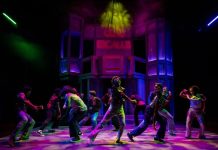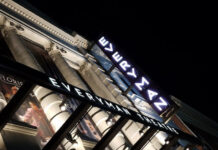Russian pianist Olga Kern is something of a cult figure because of her landmark victory in the 2001 Van Cliburn International Piano Competition in Fort Worth, captured in one of the greatest documentaries ever made about classical music, The Cliburn: Playing on the Edge.

After seeing Olga perform Thursday evening with the Baltimore Symphony Orchestra at The Music Center at Strathmore, you can count me in the cult. Expect me to seek new recruits. In fact, I’m doing that right now.
Olga’s performance with the BSO of Sergei Rachmaninoff’s Rhapsody on a Theme of Paganini was magnificent in every possible way. Her playing is lyrical, virtuosic, interpretive, and inventive all at the same time. Her collaboration with Marin Alsop conducting the BSO was spot-on, providing an ideal opening for the BSO’s 2015-2016 Washington area season at Strathmore. Baltimoreans have the chance to catch the same act Friday and Saturday at Meyerhoff Symphony Hall.
Key to Olga’s performance of the Rachmaninoff Paganini Rhapsody is a superb yet flexible keyboard technique that carries her through the composition’s theme and 24 variations over the course of a little under a half hour. Her technique is based on perfect weighting of the forearms, wrist and hands in which the finger action is simply the final piece of the puzzle. With this she draws a gorgeous “raindrop” tone out of the piano, especially in its middle range which can easily disappear into the thick orchestration in other performers’ hands.
The same weighting action also helps produce the bass thunderbolts that are present in every Rachmaninoff work without the sound going dry or the exact key of the piano’s bottom register sounding muddy. At the same time Olga does not hesitate to turn her wrists upward at points of maximum drama to give an extra push to the key action in the big parallel two-handed chords for which Rachmaninoff is famous (or, in some intellectual musical circles, scorned for writing tonal “Romantic” music well into the 20th century).
Maestra Alsop, who is increasingly becoming a global classical music superstar and had just returned from leading the prestigious “Last Night of the Proms” concert at London’s gigantic Royal Albert Hall, played directly into Olga’s strengths and preferences. Right from the opening passages, Ms. Alsop periodically had the BSO lay down a theme and then let the floor fall out from under the music, only to build it back up over the course of the variation in question.
In this way she was imitating a move captured for all time in the 2001 documentary by the brilliant conductor James Conlon (still active at the Metropolitan Opera and elsewhere) who, after consulting with the young Olga about her preferences, had the strings in the Fort Worth Symphony Orchestra open the Rachmaninoff Piano Concerto No. 3 and then immediately dive into what he told them should be simply a “sofa” of sound to support the piano entrance. I’ve never been more engrossed watching video of a rehearsal!
The documentary of course later presents the actual concert performance of the “Rachmaninoff Third” with which Olga won the Van Cliburn gold medal. The subtext for Olga appearing 14 years later with the BSO with another iconic Rachmaninoff composition is that the Rhapsody actually had its 1934 world premiere at the Lyric Opera House in Baltimore with the composer (who had moved to America after the 1917 Russian revolution) at the piano, albeit with the Philadelphia Orchestra behind him.
Like every big Rachmaninoff composition, the Rhapsody has an “aha!” moment where there’s a sudden appearance of a theme that has since been absorbed into popular culture. Other pianists have talked about experiencing the audience reaction to the 18th variation (if you don’t recognize it at first, you will when the orchestra enters at 0:47 of the link) as an intake of breath or a surprised sigh of satisfaction. At Strathmore it was more a sudden disappearance of that odd little undercurrent of audience emissions that accompanies live classical music (about which entire academic studies have been performed – it’s apparently a learned cultural behavior, at least in America). For that alone I was grateful to Olga Kern! She also added an extra touch of rubato, or a series of brief melodic hesitations, to the opening solo portion of the 18th variation, making the sweeping orchestra entrance that much more delicious.
The Rachmaninoff Paganini Rhapsody was actually not the biggest piece on the BSO’s season-opening program. That honor went to An Alpine Symphony by Richard Strauss, a 1915 musical depiction of a day spent by mountain climbers in the Alps, complete with sunrise, sunset, lost trails, birds, wild animals, thunder and lightning, and an apotheosis of reaching the summit.
This 50-minute stemwinder is controversial for having been provided a comprehensive “program” by Strauss in which you are supposed to understand its 22 segments from the music alone. It’s a favorite of Ms. Alsop because of her past experience living in the Rocky Mountain region. But in a way it’s too direct and bombastic – An Alpine Symphony calls for not only eight French horns played both onstage and offstage, but also some unusual (and very large) percussion instruments that quite literally produce sounds of thunder in almost more of a “sound machine” than musical fashion. It’s also a difficult piece and the BSO’s brass section was not as letter-perfect as it can be, although it was their first bite at the apple and they get two more tries at the Meyerhoff.

My own preference is for the greater subtlety and imagination called for by other nature inspirations like Beethoven’s Pastoral Symphony and, especially, Vivaldi’s The Four Seasons, still popular after lo these hundreds of years. But the Strauss bombast may have served well as a season introduction, and not to fear: the BSO takes up the Beethoven Pastoral later this month and regularly performs The Four Seasons with concertmaster Jonathan Carney playing the solo violin part. Anyone who connects nature with music has a cornucopia of choices from the Baltimore Symphony Orchestra in what is now its centennial season.
Running Time: 2 hours, with one 20-minute intermission.
Pianist Olga Kern and the Baltimore Symphony Orchestra performed on Thursday, September 17, 2015 at 8 p.m. at The Music Center at Strathmore – 5301 Tuckerman Lane in North Bethesda, MD. They will perform the program at the Joseph Meyerhoff Symphony Hall – 1212 Cathedral Street, in Baltimore, MD, on Friday, September 18 at 8 p.m. and Saturday, September 19 at 8 p.m. For the BSO’s complete upcoming concert schedule, see their ticket calendar.




